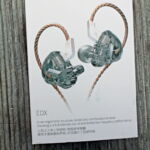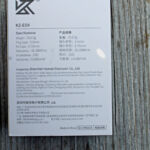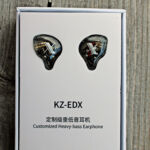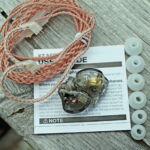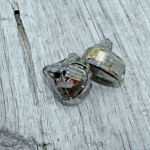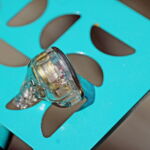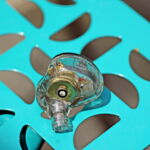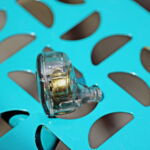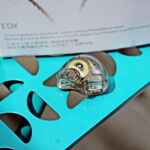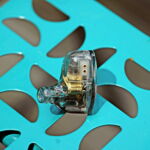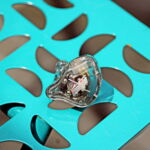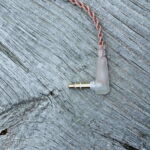KZ EDX
disclaimer: No disclaimer needed, I purchased two newer models of KZ in-ears to see where they were today. I bought the EDX and DQ6 from Aliexpress without disclosing that I was a reviewer or using an account associated with my reviews so have every reason to believe these are standard production samples and not something selected for review.
Unboxing / Packaging:
Those familiar with KZ packaging will find no surprises here. White slipcover with picture of earpieces on front, specs on reverse, and mic/color noted on side. Inside we have the foam tray with the earpieces on top with the cable and tips hiding beneath. The package contains 3 sets of silicone tips, the cable, and the earpieces. It is pretty sparse by current standards but we do have to remember that the EDX also retails for less than 10 USD.
Build/Fit:
The EDX shell is a small semi-custom inverted teardrop of clear acrylic material that allows full view of the driver and wiring. There is a silver X on the face plate to identify the model and “KZ EDX” and “bass dynamic” printed on the top edge of the inner shells. There are two vents on the inner surface, one directly over the center of the driver and a second near the outside edge of the drive close to the top of the inner surface. Bi-pin connectors are interesting in that the connector itself is recessed in the shell, but also stands taller than the recess so a semi-hooded connector is mated to it and both the shell and casing on the connector provide additional support. Nozzles are part of the inner shell with a slight upward and forward rake when in wearing position and a prominent lip for tip retention. I found them to be an easy fit when paired with the large tips and comfortable for extended wear. Isolation is only average due to the small size and construction style.
Internals:
The EDX is a return to their roots for KZ with a single 10mm dynamic driver with a composite diaphragm. We have grown so accustomed to seeing titanium, carbon nano-tubes, beryllium, or whatever today’s super material is, that we don’t think much about a good old fashioned dynamic driver but this is where KZ started out years ago and for the first couple years of their existence, their entire product line was single dynamic drivers and their first dual driver was twin dynamics. The EDX has a nominal impedance of 23Ω but in my testing varied from around 22Ω up to about 38Ω depending on the frequency used to test with. Sensitivity is listed as 112 dB/mW making the EDX easy to drive and as a result it really doesn’t need or benefit from a more potent amplifier.
Cable:
The cable is standard KZ in some respects and improved in others. The 90º 3.5mm jack, Y splitter and hooded bi-pin connectors are all still the style we have come to know and expect from KZ, this time in translucent plastic that allows the copper cable show through. The cable itself is a 4 wire double twist from jack to splitter and twisted pair above that point. My sample did not have a mic but the option does exist if you prefer that. The cable uses a clear casing show the copper shows and it is a prettier cable than the older brown style. Time will tell if the cable stays bright copper or starts to take a on green tint over time. No green is present so far, but my time with the EDX has only been a few weeks. Also worth noting, the connectors are a semi-hooded bi pin with a square design and fit into a recess in the EDX shell so finding a replacement 0.75mm bi-pin cable with the same style connectors may be a bit more challenging than a standard cable would be.
Sound:
Bass:
This is the star of the show with the EDX. It should be a tip off that the units actually say “Bass Dynamic” on the shells. Sub-bass rumble is elevated quite a bit with a center around 60Hz and roll-off only becoming evident in the mid 20Hz range. While sub-bass is big, it does have some texture so doesn’t come across as too monotone. It is a bit dirty though with a bit of thickening as tracks get busy and the bass won’t compete for quality and detail level with more expensive models. Mid-bass shares the elevation of the sub-bass but then drops back as we move toward the mids. Unfortunately, it also shares in the thickening and a bit of detail loss due to driver speed issues.
Mids:
Lower mids are at the bottom of the V on the EDX and do sound a bit recessed especially compared to higher vocals with the big push forward of the upper-mids. There is some mild bleed as well that keeps the lower mids from being crisp and clean. As we move up through the mids, the sound goes from mildly recessed to aggressively forward with the upper-mids leaving the EDX sounding a bit shouty with higher vocals and strings a bit tinny and off-timbre. The EDX definitely is more at home with rock or hip-hop than opera or string concerto and is probably best limited to popular genres due to that over-stated upper mid push.
Treble:
Lower treble starts out on the same plateau of the upper-mids, but treble sort of wanders around a good bit above that mark. After the initial climb, it drops back some, then peaks again at around 4.5kHz, and again at 9kHz and 11kHz before finally rolling off somewhere over 14kHz. Those wondering what the definition splashy treble is could use the EDX as a benchmark of what reviewers are referencing. Treble can be both thin, and harsh with a tendency to live right on the cusp of sibilance. Cymbals are metallic and very clicky rather than having a more natural tonality. The good news, is there is enough top end to sound open but the problem is sparkle turns to sizzle as often as not.
Soundstage / Imaging:
Stage is average with more width than depth by a margin of nearly 2:1 and while it has some height it stops well short of better models. Instrument separation is passable and keeps seating the orchestra from being a complete disaster as the stage width makes it awkward and a lack of layering doesn’t help. Imaging is reasonable but not super precise as well. There is a lot of compression evident as tracks get busier and more complex which does impact the imaging and instrument separation as well and the EDX does best with fairly simple compositions with limited voices in the mix. Again, good for rock,edm, pop, hip-hop. Less so for Jazz and classical.
Thoughts / Conclusion: <NM>
It would be easy to bust on the EDX as it honestly is not great at anything but then we have to consider it has removable cable, costs less than $10, and is well made. It’s cheap enough to supply everyone going on the canoe trip a pair and still be out $45 if all of them get ruined along the way. This is where the EDX is perhaps at its best, those situations where you either don’t want to risk your better in-ears like the beach, or those people where risking a higher priced model doesn’t make sense. Years ago I used to test budget earphones by putting them in the pocket of a pair of Levi Jeans and running them through a full wash and dry cycle. My children had done this to quite a few electronic devices (sansa clip player, numerous earphones, thumb-drives, etc) and very few survived it. While I certainly don’t recommend abusing your gear, the fact remains that some people take better care of things than others and for those that destroy earphones frequently something like the EDX makes a lot of sense. Its bass forward tuning will appeal to a lot of youngters, while its price will appeal to parents. I picked up a couple extra pairs just to have when somebody says “hey do you have a spare pair?”
-
Bass - 6.5/106.5/10
-
Mids - 5/105/10
-
Treble - 5/105/10
-
Soundstage - 5/105/10
-
Imaging - 6/106/10
Summary
Pros: solidly built, dirt cheap, Big bass
Cons: not a natural tonality, harsh upper-mids/lower treble, sizzle.


